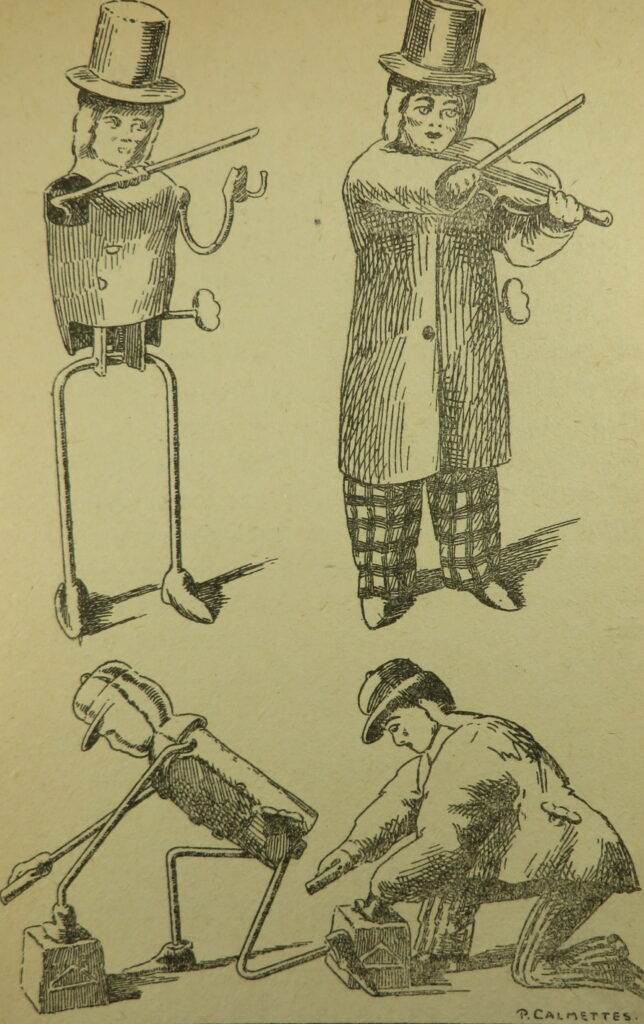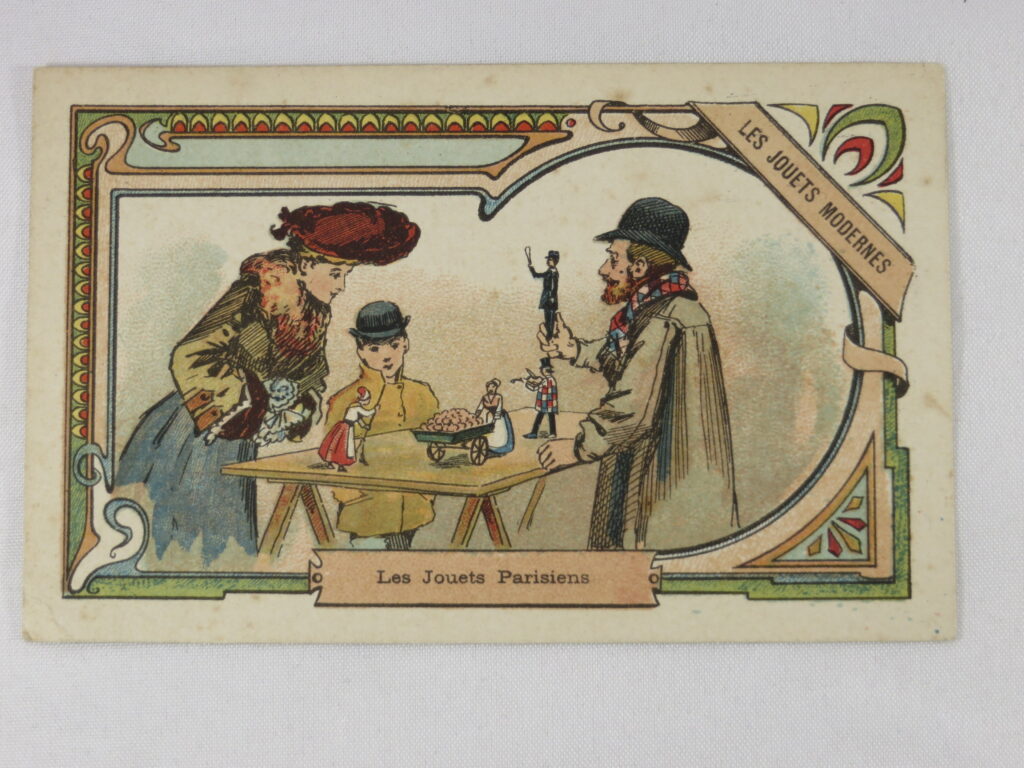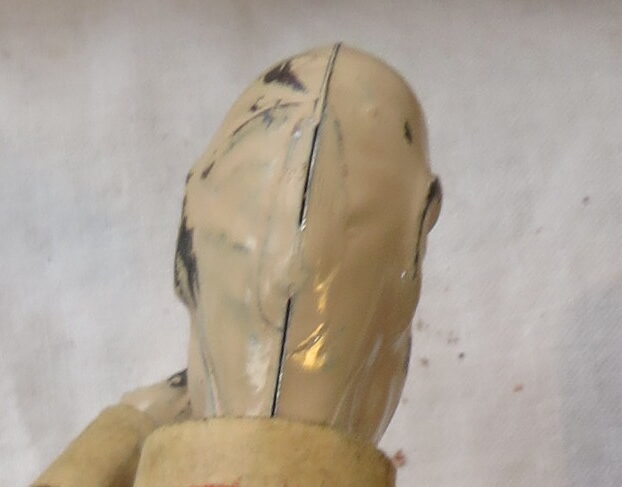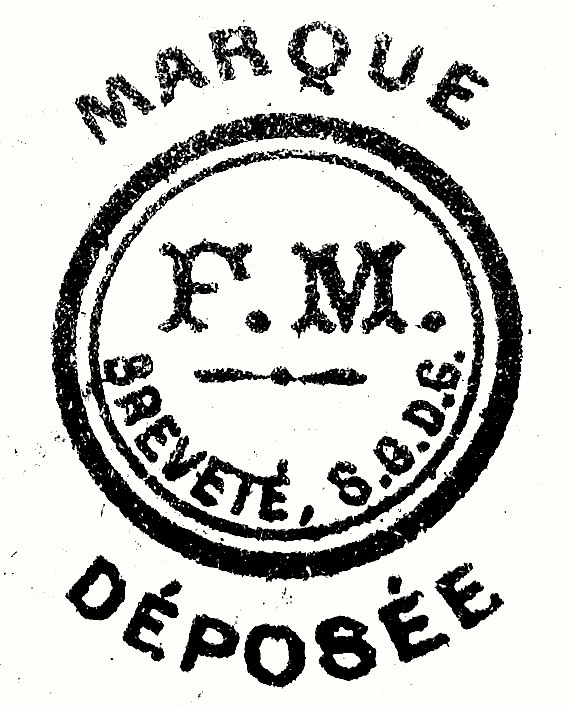This is a free translation of part of the book LES JOUJOUX written by Mr. Pierre Calmettes in 1924, he was a painter and man of letters, he wrote a number of books, one of which was about toys, he was not a real toy connoisseur and in his book there are several statements that are not entirely in line with the facts as we now know them, I have tried to adjust that as much as possible in this translation.
It describes the production of the Fernand Martin toys and it follows a toy, the “Les Agents”, from the very beginning to the finished product.
He also discusses the great sales success and the how’s and whys of the later slump in toy sales. Some texts have been adapted or provided with small additions to clarify the text.
The original text in the book LES JOUJOUX is in French.
This article will be published in 5 episodes
THE PRODUCTION OF TOY MECHANICAL TOYS
Not all metal toys, like the ones we’ve researched, are simple tin bits, cut, stamped, stapled and painted.
There are other toys, the manufacture of which is more complicated and better cared for, which break less easily, and which are preserved even as amusing trinkets; those are the mechanical toys.
When we see them maneuvering and when we see their low price, it seems that these animated toys should be easy to manufacture and devoid of technical difficulties and make those other trinket productions random and narrative.
But when we set ourselves the task of studying their preparation, we find that their manufacture requires patience, research, great ingenuity, the construction of machines, the building of huge factories, and above all the assembly of great capital, In the factories dedicated to toys, we can visit the workshops reserved for ordinary metal toys, in addition, there are the workshops dedicated to toys made of wood, paper or cardboard.
On the contrary, the manufacture of metal mechanical toys is completely occupied by workshops that only deal with these automata toys.
The simplification of the work here is the essential factor for its multiplication.
The workers who work in these workshops always make the same pieces from the same toys.
Some take care of the cutting, others assembling, adjusting, painting or dressing.

The toys they make are generally current toys, toys that have to be designed and built in a few days and the construction of which has to use all known industrial resources, mechanics and manuals.
We have all seen, whether on the shelves of the shops or on a Parisian sidewalk presented by the street vendors, these small articulate figures, popular for the diversity they represent and for their selling prices.
The mechanisms that power them are remarkably ingenious, they transmit movements to these toys that imitate people’s gestures so well that we can’t watch them without laughing.
In writing this story about these toys, let’s introduce the reader to the father of these little automata, Mr. Fernand Martin. We thus give a sufficient description, so that we no longer have to worry about their anatomy, the preparation and reunification of the parts that make up the elements.
In Paris, where this toy was born, there is an imposing factory on the old boulevard de Ménilmontant.
When we visited it recently, we remembered our first meeting with the inventor of these automata, which is quite a few years ago at the time of the first Lépine competition in 1901.
This Martin factory had already been founded in 1880 and at our first met all the global success it deserved.

After his retirement and later his death in 1919, Mr. Fernand Martin left the factory and its inventions to his successors, so as Mr. Bonnet , with the dual task of running it and expanding it further.
The visit to this factory is very exciting and for those who are interested in toys and want to know the why and the how, they will be able to study the operation of the machines in the workshops.
More sophisticated cutters, punches, mechanics of all sizes and tools of various shapes for the most numerous operations, have to be operated by the skilled hands of workers, and they are entrusted to these workers. all small actions that require the care and patience of the performers.
The workers also all have their own tasks such as welding, melting lead for certain parts and preparing the engines.
When we make a selection of the work that these workers do in the Martin factory, we discover that these automata are built on the basis of anatomical principles and very simple shapes such as the iron frame.
This frame contains the winding spring and the gears of the mechanism.
The frame is topped by a head stamped and painted in brass and placed on wire legs, the arms are also made of wire, the hands and feet are made of iron and lead.
Fabrication is sometimes even simplified by removing the arms and simply gluing a cardboard hand to the end of the floating sleeve.
But before you are interested in assembling the small vending machines, you must first attend the preparation of all the parts,
it starts from the receipt of the raw material on arrival at the factory, its distribution to the different workshops.

The raw material, or rather the raw materials used here are tinplate and black iron, lead, antimony, copper and brass, steel, nickel, silver, the felt, cardboard, paper and various paints.
One of the first operations consists of rolling the black iron, to bring them to the reduced thickness that allows them to be cut.
These are workers who feed the metal sheets under the blades of the rollers and then under the shears that cut them into pieces.
These pieces are the base, they are punched/cut according to the shapes indicated by the model.
The scissors punch/cut hundreds and hundreds of them, on which we can already see the presence of notches or iron tongues, which, by their presence, will allow the solid and rapid assembly of all fragments of ‘automatics’.
When leaving the cutting workshop, the parts go to the stamping workshop.
They all fall into machines that bend, pierce, shape the piece of iron and do in a minute the work that would take at least an hour of manual labor.

We stamp the bodies and heads in two parts, the hands with a single wave of the garland and all these pieces are thrown into baskets while waiting to be used.
The pieces of the head are taken to the welders who will put them together two by two, adding the skull to the face.
Read next time further in part 2.
